A Revision of One’s Calling: A Journey through Embodied Experience. A blog post by Melissa Nazario, based on an Interview with Elizabeth Wisniewski, D.C. by Bonnie Bright, Ph.D.
Listen to the full audio interview with Elizabeth Wisniewski here. (approx. 28 minutes)
 In her first summer fieldwork as a student of Pacifica’s Ph.D. Program in Depth Psychology with Specialization in Somatic Studies, Elizabeth Wisniewski, a doctor of chiropractic, yoga instructor, and reiki practitioner, guided students through a blindfolded yoga meditation and painting class, followed by group process. The students, she said, found it scary and uncomfortable at first, but after about twenty minutes, they noticed that they were no longer competing with others in the class, nor competing with themselves to get into some crazy asana or pose.
In her first summer fieldwork as a student of Pacifica’s Ph.D. Program in Depth Psychology with Specialization in Somatic Studies, Elizabeth Wisniewski, a doctor of chiropractic, yoga instructor, and reiki practitioner, guided students through a blindfolded yoga meditation and painting class, followed by group process. The students, she said, found it scary and uncomfortable at first, but after about twenty minutes, they noticed that they were no longer competing with others in the class, nor competing with themselves to get into some crazy asana or pose.
While these classes and fieldwork were an opportunity to allow her students to have an embodied experience, they also served another purpose: to bring people more into Elizabeth’s experience of not having sight. At the age of six, Elizabeth was diagnosed with a rare eye disease. By the age of 14, her retina detached, and she lost vision in her right eye. Not letting that stop her natural curiosity and passion for learning, she earned a bachelor’s degree in political science and environmental studies at The University of Montana, took the LSAT, and was on track to become an environmental attorney.
However, she soon realized that law wasn’t her passion, and returned home to Michigan. Then, at just 21 years old, everything changed. She underwent her 30th eye surgery, but it went terribly wrong, and she lost almost all her vision in her left eye. With her eye patched up and in massive pain, Elizabeth was confined to her parents’ house, devastated at what not having sight meant for her future.
 Then, while recovering, Elizabeth heard a radio commercial for a medical massage school that was started by a chiropractor in Michigan. She had always had an interest in massage, and her friends often asked her for massages. She thought she’d go to massage school and then do massage to pay her way through grad school, earning a master’s degree in political science. However, three weeks into the massage program, while taking anatomy and physiology, classes she’d never taken before, Elizabeth’s perspective completely shifted, and she realized that she was so passionate about learning about bones and joints and anatomy, that it would completely change the course of her life and career. “So I said to my dad, thank you for paying for undergrad, I’m going to go in a totally different direction,” Elizabeth recalls. “And it was really scary but he got it, and supported me from that moment, and so I went back and took all my science classes, chemistry, physics, I took everything verbally, all my exams, and was getting 100 percents in chemistry, doing all mental math.”
Then, while recovering, Elizabeth heard a radio commercial for a medical massage school that was started by a chiropractor in Michigan. She had always had an interest in massage, and her friends often asked her for massages. She thought she’d go to massage school and then do massage to pay her way through grad school, earning a master’s degree in political science. However, three weeks into the massage program, while taking anatomy and physiology, classes she’d never taken before, Elizabeth’s perspective completely shifted, and she realized that she was so passionate about learning about bones and joints and anatomy, that it would completely change the course of her life and career. “So I said to my dad, thank you for paying for undergrad, I’m going to go in a totally different direction,” Elizabeth recalls. “And it was really scary but he got it, and supported me from that moment, and so I went back and took all my science classes, chemistry, physics, I took everything verbally, all my exams, and was getting 100 percents in chemistry, doing all mental math.”
That passion would drive her to the next step of her journey as a lifelong student of the body: chiropractic school at Palmer’s in San Jose, California. After becoming a doctor of chiropractic and starting her first practice in Santa Barbara, she explored other modalities as well. “I became a yoga teacher, and I practiced bakhti yoga and played the harmonium and chanted kirtan and just became really deeply rooted in those lineages,” Elizabeth says.
“Somatics, being the lived experience of the body, pulled me deeper into that of my practice, the chiropractor, because it’s not just manually moving bones and joints, you’re having this deeply spiritual and emotional connection with each patient, with the laying on of hands, that I couldn’t deny anymore, and wanted to do even more. So if you look at mind, body, spirit, soul, psyche, planet, I have this environmental degree, covering the planet part, and I understand anatomy, physiology, and have the yoga connection with the spirit, but I wanted more. I love school, obviously, so it worked, but I wanted that full experience that was vitalistically rooted for my patients and for my own practices, and Somatics seemed like the best fit.”
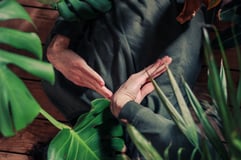 Being at Pacifica has enabled Elizabeth to pull from and integrate each of the fields of knowledge she’s studied. For example, she’s been able to apply her undergraduate coursework on the environment to the ecopsychology course within Pacifica’s Somatics program. But Elizabeth keenly observes that her learning is more than attaining knowledge and is instead something that is used and applied. She references her father, who has described her approach to learning as more akin to being a farmer, in which one is harvesting knowledge, instead of merely having specific expertise. Pacifica, she says, allows her to do that.
Being at Pacifica has enabled Elizabeth to pull from and integrate each of the fields of knowledge she’s studied. For example, she’s been able to apply her undergraduate coursework on the environment to the ecopsychology course within Pacifica’s Somatics program. But Elizabeth keenly observes that her learning is more than attaining knowledge and is instead something that is used and applied. She references her father, who has described her approach to learning as more akin to being a farmer, in which one is harvesting knowledge, instead of merely having specific expertise. Pacifica, she says, allows her to do that.
This roundabout journey into the field of embodied work and research, of being called first to the field of chiropractic, and later pulled toward Pacifica, is all connected and interrelated to her personal life story. “I know that when my soul made this contract with losing my eyesight, that this was part of the journey,” she remarks. “So I’m so grateful because every part of me believes that I wouldn’t be a chiropractor, I wouldn’t be a yoga teacher, I wouldn’t be doing what I’m doing if I could still see.”
Incorporating blindfolded painting into her fieldwork has also been a part of her personal journey of losing her sight. When she was growing up, Elizabeth painted all the time, but felt she had lost the opportunity to paint along with losing her sight. She still can see sunlight, however, and remembers what every color looks like. Interestingly, all the scar tissue from all her eye surgeries resulted in her seeing nebulous swirling colors whether her eyes are open or closed, which has been both distracting and painful, according to Elizabeth. Recently, however, she’s changed her relationship to it. About two and a half years ago, she started painting again with a teacher, and knew what specific paint colors to ask for. Then, when she started painting alone, she began to choose paint based on the energy she felt from the bottles. It was this practice that led her to shift from desiring a specific outcome in her painting, to focusing on the process itself.
Elizabeth recognized in her first fieldwork class at Pacifica, during a meditation on tapping into their calling, that her passion was expression through the arts, and she wanted to bring people with sight into her experience. However, there was another motivation for working with people with sight.
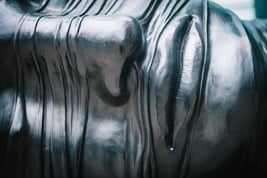 “Part of my mission I feel is to shift our perspective of living in a very visual world, and to change the relationship,” Elizabeth says. “So often there’s negative connotation around the word ‘blind,’ and we use it in such a way, like ‘I was blindsided by this,’ or ‘I was blinded by the light,’ and it’s a really negative, pejorative way of using it.”
“Part of my mission I feel is to shift our perspective of living in a very visual world, and to change the relationship,” Elizabeth says. “So often there’s negative connotation around the word ‘blind,’ and we use it in such a way, like ‘I was blindsided by this,’ or ‘I was blinded by the light,’ and it’s a really negative, pejorative way of using it.”
Elizabeth believes it’s time to reconsider both the language and attitudes we have for people without sight. “I think the word ‘blind’ really deserves to have therapy provided for that word and that term so that we can shift our perspective in our society, because 50% of people who can’t see in the United States are unemployed, and so for me that’s really unacceptable,” she remarks.
“I want to provide mainstream people, sighted people, with that information so that we can help to empower people who cannot see because we’re seeing more people coming back from the wars in Iraq and Afghanistan with high trauma and loss of vision. There is a lot of research going on because of that, but also with the baby boomer generation, there’s going to be more and more money put into that area of research, so I feel that it’s important to change our perspective toward the word and people who cannot see.”
Part of that shift in perspective, Elizabeth posits, is toward a deeper knowing or insight. “So, I want to change sight to the deep seat of knowing, which taps more into our third eye, the pineal gland, and that’s where it really evolved from, and I’m moving forward in this next summer’s fieldwork and towards dissertation in that same vein.”
This summer, Elizabeth has two different fieldwork projects in mind. For one, she is flying to Todos Santos, Mexico, to teach some retreats at a boutique hotel, as well as in the community. “I’ve actually been calling them ‘unretreats,’ because ‘retreat’ to me is moving backwards, and often people go on retreat and they learn all this, but they don’t fully incorporate it, and they go back into this fight or flight stressful world. So, to unretreat, you want to forge ahead in advance,” Elizabeth says.
Additionally, Elizabeth is looking to study under an indigenous bone setter, “which is the precursor to chiropractic found in every culture around the world going back 5,000+ years,” she says.
“In Western bone setting, Hippocrates said, ‘Look well to the spine for the cause of all disease.’ And that’s certainly part of the chiropractic philosophy. So, I’m always very intrigued by that quote and curious, and I also have a lot of inquiry around what it’s like for someone to move bones and joints who doesn’t know that this is the tibia. It has this perspective that it’s a lineage that’s passed down without formal education, and how they learn that and feel the energy of the body.”
Elizabeth is also interested in the Eastern traditions of healers without sight. “Many traditions of Eastern hands-on healing originally had people who could not see doing them, so I would love to study with somebody who couldn’t see, perhaps, to learn bone setting,” she says. “I don’t know the full history, but I do know that it’s still found. You can go in the Amazon, and within the tribal culture there’ll be a bone setter there.”
 Understanding that chiropractic has a long history with roots in bone setting helps to provide perspective when people dismiss it. “When people say ‘I don’t believe in chiropractic,’ I have a couple things where, well it’s not a belief system, this isn’t a dogmatic approach to health care,” says Elizabeth. “It’s a science and an art and a philosophy, but also, how can you not ‘believe’ something that’s been around for thousands and thousands of years that has clear evidence through its existence? And it doesn’t have to be through a peer-reviewed article, but just the fact that it still exists for so many thousands of years is proof to me that there’s something there.”
Understanding that chiropractic has a long history with roots in bone setting helps to provide perspective when people dismiss it. “When people say ‘I don’t believe in chiropractic,’ I have a couple things where, well it’s not a belief system, this isn’t a dogmatic approach to health care,” says Elizabeth. “It’s a science and an art and a philosophy, but also, how can you not ‘believe’ something that’s been around for thousands and thousands of years that has clear evidence through its existence? And it doesn’t have to be through a peer-reviewed article, but just the fact that it still exists for so many thousands of years is proof to me that there’s something there.”
Furthermore, Elizabeth notices that her chiropractic practice is able to treat patients holistically and often get to the root of her patients’ ailments better than conventional models of treatment. “I see that in my chiropractic practice every day where somebody comes in, and let’s say they elbow pain and I’m like, but what’s been done?” she says.
“And all they’ve done is looked at the elbow, and it’s like, let’s start at the spine where the nervous system, the master system is, and then go from there, and often it’s not the elbow. It’s such a small example, but I see it so often from the allopathic model, it’s hard for me not to say ‘allopathetic’. Western medicine has its place and I don’t discount that, but I think it’s really important that we look at the whole body and beyond and the energy system and everything, otherwise it’s a disservice to our clients and patients.”
Studying at Pacifica, Elizabeth notes, helps her to personally work toward integrating her whole self as well. “I feel like it’s that making of wholeness that Pacifica’s really been helping me with,” she remarks.
“Part of it is we’re required to have our own depth transformative hours, which is going to therapy. It’s really nice when you’re mandated. So you can work through your things that you need to, and I was dissolving my last business the first year, so I had a lot happening, starting a brand new practice, going through a lot of trauma based out of developing a business with somebody. There was so much, but Pacifica’s helped me with raising that shakti divine energy within myself, to feel more whole, and it’s in that aspect that I’ve really been able to find myself. Jung talks about the most terrifying thing one can do is to know themselves, and for a long time, I felt I was this more masculine perspective of Napoleon Hill thought from Think and Grow Rich, turn your disadvantages into assets, which I do find valuable. My challenge has been losing my eyesight, but my assets are my hands and my heart space, and I can still practice. And so I did a lot of motivational speaking and writing for many years through that model. But now through Pacifica I’m seeing there’s another way of looking at it from Hillman’s work, of looking backward on your life, looking at, my soul made this contract. This is where I am now, but looking back, I was preparing for this. I already knew that this was going to happen. And so it’s shifting my own body, which allows me that perspective and has shifted the paradigm of my life into more connectedness within my own body, which allows me to be connected to my community.”
Learn more about the M.A./Ph.D. in Somatic Studies Specialization
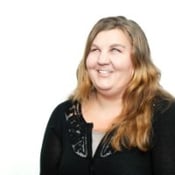 Elizabeth Wisniewski, Ph.D., grew up in Michigan and attended The University of Montana, where she received her B.A. in Environmental Studies and Political Studies in 2006. She earned her Doctor of Chiropractic at Palmer College of Chiropractic in 2012, and she’s a registered yoga teacher and medical massage therapist. Currently, Dr. Wisniewski has a private practice in Santa Barbara, California, and is in her second year at Pacifica Graduate Institute in the Somatic Studies Program.
Elizabeth Wisniewski, Ph.D., grew up in Michigan and attended The University of Montana, where she received her B.A. in Environmental Studies and Political Studies in 2006. She earned her Doctor of Chiropractic at Palmer College of Chiropractic in 2012, and she’s a registered yoga teacher and medical massage therapist. Currently, Dr. Wisniewski has a private practice in Santa Barbara, California, and is in her second year at Pacifica Graduate Institute in the Somatic Studies Program.
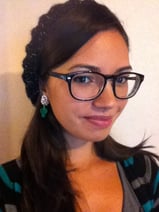
Melissa Ruisz Nazario is a graphic designer and social media consultant for Pacifica Graduate Institute. She is also the production manager and webmaster for Immanence Journal and creative director for Total Okinawa magazine. In 2006, Melissa earned an M.A. in English and American literature at the University of Texas at El Paso (UTEP). Her thesis, “Parting the Shadowy Veil: Trauma, Testimony, and Shadow in Toni Morrison’s Beloved” received UTEP’s 2006 Honors Convocation Award for Outstanding English Thesis. Melissa has served as a content editor and graphic designer for the U.S. Marine Corps Public Affairs Department in Okinawa, Japan, as well as a technical writer and quality assurance specialist for Advanced Computer Learning Company in North Carolina. As an educator, she has taught college-level literature, composition, and drama; she also taught English as a second language to adults and children in Japan.
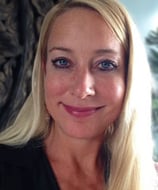 Bonnie Bright, Ph.D., earned her doctorate in Depth Psychology at Pacifica Graduate Institute. She is the founder of Depth Psychology Alliance, a free online community for everyone interested in depth psychologies, and of DepthList.com, a free-to-search database of Jungian and depth psychology-oriented practitioners. She is also the creator and executive editor of Depth Insights, a semi-annual scholarly journal, and regularly produces audio and video interviews on depth psychological topics. Bright is especially interested in ecopsychology, dream work, and divination, and has completed 2-year certifications in Archetypal Pattern Analysis via the Assisi Institute and in Indigenous African Spiritual Technologies with West African elder Malidoma Somé. She has also trained extensively in Holotropic Breathwork™ and the Enneagram.
Bonnie Bright, Ph.D., earned her doctorate in Depth Psychology at Pacifica Graduate Institute. She is the founder of Depth Psychology Alliance, a free online community for everyone interested in depth psychologies, and of DepthList.com, a free-to-search database of Jungian and depth psychology-oriented practitioners. She is also the creator and executive editor of Depth Insights, a semi-annual scholarly journal, and regularly produces audio and video interviews on depth psychological topics. Bright is especially interested in ecopsychology, dream work, and divination, and has completed 2-year certifications in Archetypal Pattern Analysis via the Assisi Institute and in Indigenous African Spiritual Technologies with West African elder Malidoma Somé. She has also trained extensively in Holotropic Breathwork™ and the Enneagram.



